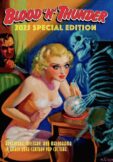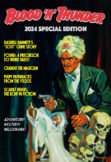EDitorial Comments
Unfairly Dissed and Dismissed: FAMOUS FANTASTIC MYSTERIES
You see copies everywhere. At conventions for collectors of vintage pulps, practically every dealer has some among his stock. They appear on eBay in vast quantities; many weeks you can find multiple listings of the same issue. They even pop up in places you rarely find old fiction magazines anymore: garage sales, antique stores, flea markets. No doubt about it, as vintage pulps go, Famous Fantastic Mysteries is darn near ubiquitous. And it’s this omnipresence that prevents today’s science-fiction fans and collectors from taking the magazine as seriously as it deserves.
Famous Fantastic Mysteries was launched in 1939 by the Munsey organization (then operating under the brand name “Red Star Publications”) to capitalize on the sudden boom in science-fiction pulps that in little more than a year had already spawned Planet Stories, Startling Stories, Science Fiction, Marvel Science Stories, and Dynamic Science Stories. The editorship of FFM was entrusted to 42-year-old Mary Gnaedinger, a long-time Munsey staffer. As the once-mighty company had fallen on hard times and was struggling to hold market share, Gnaedinger was instructed to fill the new pulp with old stories—fantasy, horror, “scientific romance,” and lost-race adventure—culled from early issues of such venerable Munsey titles as The Argosy, The Cavalier, and (most prominently) The All-Story and its successor, All-Story Weekly. Only the works of Edgar Rice Burroughs were off-limits to her; ERB had cannily retained reprint rights to his imaginative adventure yarns.
FFM‘s first issue (September-October 1939) featured seven complete stories, including two fan favorites: A. Merritt’s “The Moon Pool”and Ray Cummings’ “The Girl in the Golden Atom.” The second issue began Merritt’s novel-length sequel, “The Conquest of the Moon Pool,” which was serialized over six issues.
In fairly short order Gnaedinger reprinted well-remembered yarns by some of All-Story‘s best-known contributors of fantastic fiction: George Allan England, Garrett P. Serviss, Homer Eon Flint, Austin Hall, J. U. Giesy, Francis Stevens, Garret Smith, Ralph Milne Farley, Charles B. Stilson, and Edison T. Marshall, to name a few.
FFM introduced a new generation to these classic stories but also fired the enthusiasm of veteran pulp readers who deluged Gnaedinger with requests for dimly remembered stories initially published 10, 20, and even 30 years earlier. As many of these were book-length tales, she persuaded Munsey president William T. Dewart to launch a companion magazine, Fantastic Novels, in which to spotlight the longer stories. Eventually, FFM too ran novels complete in one issue, forcing Gnaedinger occasionally to cut excess wordage. This practice earned her the undying enmity of some SF purists, but in truth some of those stories benefit from the trims.
The sure-handedness of Mary Gnaedinger’s stewardship of FFM led Popular Publications president Harry Steeger to retain both her and the magazine when he bought the Munsey line from Dewart in late 1942. With a more generous editorial budget than she had been allotted previously, FFM‘s editor expanded the magazine’s horizons by purchasing reprint rights to works not originally published by Munsey. Within just a few years she had ushered into its pages such fantastic-fiction luminaries as Arthur Machen, Lord Dunsany, H. G. Wells, Robert W. Chambers, H. Rider Haggard, and William Hope Hodgson.
The first handful of FFM issues sported no cover artwork, instead merely listing authors and story titles. This approach, common to literary journals, hadn’t worked for editor Arthur Sullivant Hoffman when he tried it on Adventure in 1927, and it didn’t work for Gnaedinger. Pulp-magazine buyers looked for exciting, colorful covers. She hired Virgil Finlay and Frank R. Paul, already known by SF fans for their work in Weird Tales and Amazing Stories respectively, to provide full-color cover painting as well as black-and-white interior illustrations. After moving to Popular Publications she also acquired the services of Lawrence Sterne Stevens and, later, Norman Saunders and Rafael de Soto.
In its last few years—the early Fifties—FFM continued to reprint top-notch fiction by Talbot Mundy, Sax Rohmer, H. P. Lovecraft, Robert E. Howard, and more contemporary favorites such as Ray Bradbury, Theodore Sturgeon, and Robert E. Heinlein. The final issue (June 1953) even featured yarns by Ayn Rand and Franz Kafka alongside those of Howard and Bradbury!
I’m often asked by beginning collectors to recommend titles they should go after. I can’t think of a better one than Famous Fantastic Mysteries. The fiction is often first-rate, being reprints of classic stories, and the artwork is of similarly high quality. Moreover, as mentioned at the outset of this piece, copies are plentiful and therefore easily affordable. Not a single one of the 81 issues is rare, or even scarce. And with few exceptions each can be had, even in high grade, for less than the price of today’s average hard-cover book. I have some nice samples in my Collectibles For Sale section now.
31 thoughts on “Unfairly Dissed and Dismissed: FAMOUS FANTASTIC MYSTERIES”
Leave a Reply
Recent Posts
- Windy City Film Program: Day Two
- Windy City Pulp Show: Film Program
- Now Available: When Dracula Met Frankenstein
- Collectibles Section Update
- Mark Halegua (1953-2020), R.I.P.
Archives
- March 2023
- July 2021
- May 2021
- March 2020
- February 2020
- December 2019
- November 2019
- October 2019
- September 2019
- August 2019
- May 2019
- April 2019
- March 2019
- February 2019
- December 2018
- November 2018
- October 2018
- August 2018
- June 2018
- February 2018
- December 2017
- October 2017
- September 2017
- August 2017
- May 2017
- April 2017
- February 2017
- September 2016
- August 2016
- July 2016
- June 2016
- November 2015
- October 2015
- September 2015
- August 2015
- July 2015
- June 2015
- May 2015
- April 2015
- March 2015
- February 2015
- January 2015
- August 2014
- July 2014
- June 2014
- May 2014
- April 2014
- January 2014
- December 2013
- September 2013
- August 2013
- July 2013
- June 2013
- May 2013
- April 2013
- March 2013
- February 2013
- January 2013
- December 2012
- October 2012
- September 2012
- August 2012
- July 2012
- June 2012
- May 2012
Categories
- Birthday
- Blood 'n' Thunder
- Blood 'n' Thunder Presents
- Classic Pulp Reprints
- Collectibles For Sale
- Conventions
- Dime Novels
- Film Program
- Forgotten Classics of Pulp Fiction
- Movies
- Murania Press
- Pulp People
- PulpFest
- Pulps
- Reading Room
- Recently Read
- Serials
- Special Events
- Special Sale
- The Johnston McCulley Collection
- Uncategorized
- Upcoming Books
- Western Movies
- Windy City pulp convention
Dealers
Events
Publishers
Resources
- Coming Attractions
- Field Guide to Wild American Pulp Artists
- MagazineArt.Org
- Mystery*File
- ThePulp.Net






Ed, great piece on an often overlooked pulp. I ignored this pulp until i bought a lot on EBay where the seller had included an issue of this. I opened it and the interior artwork was a revelation. The covers are great, too. No wonder nobody who bought it could bring themselves to throw it away.
And that being so, copies are plentiful in good condition. Complete sets are offered from time to time on EBay and Abebooks. It is also very easy to assemble a complete set in less than a year, from EBay alone.
I do have to caution buyers about buying from Ed, though. He collects very high grade pulps, and if you get hold of these, you may feel unhappy about opening and reading them, and secondly, you may feel the need to buy a second copy for reading purposes only. I know I’m having that problem with some issues i got from him.